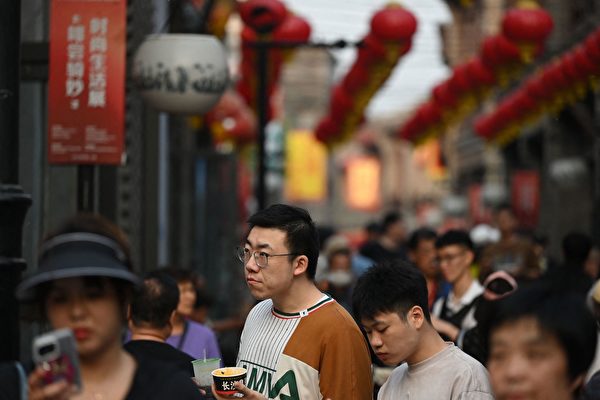The “May Day” holiday in China has come to an end, and some analysts believe that during the holiday, there have been four major phenomena in consumption, all confirming that the willingness of mainland people to consume is decreasing, their consumption capacity is declining, and the main consumer group is becoming more budget-conscious.
During this year’s “May Day” holiday, the number of people traveling reached 295 million, setting a new record, but the per capita consumption did not increase but declined. The apparent prosperity reflects a downward trend in overall consumption in China.
Mainland dining websites summarized four major characteristics of consumption during this year’s “May Day” holiday on May 8th.
First, “reverse tourism” is on fire. In the past, everyone rushed to popular cities like Beijing, Shanghai, Guangzhou, Chengdu, and Chongqing for travel, but during this year’s “May Day” holiday, more people headed to county towns. Many county towns experienced a tourism peak, with tourism orders even surpassing major cities.
Data from Ctrip shows that in terms of year-on-year growth rates of travel orders, first and second-tier cities are lower than third and fourth-tier cities, and third and fourth-tier cities are lower than county markets. On the first day of the May Day holiday, the hotel occupancy rate in county areas increased by 64% year-on-year, and ticket orders increased by over 200% year-on-year. Popular county travel destinations like Anji, Tonglu, Dujiangyan, Yangshuo, Mile, Yiwu, and Wuyuan saw an average increase of 36% in tourism orders.
It is reported that for many young people, accommodation and dining costs in first and second-tier popular travel cities are high. In contrast, many small county towns have unique folk culture and attractions, with lower prices and relatively fewer crowds. Going to the county market for a leisurely food and drink trip is more cost-effective and relaxing.
Second, the number of marriages has plummeted sharply, leading to a bleak wedding banquet market.
The “May Day” and “National Day” holidays have traditionally been peak seasons for weddings and banquet businesses, with hotels and restaurants bustling with wedding receptions. However, during this year’s “May Day” holiday, the number of marriages plummeted drastically, turning it into a wedding off-season.
An insider in the wedding industry revealed to the self-media “定焦” that in May this year, their company handled 1166 weddings nationwide, a decrease of 25.78% year-on-year; of these, during the May Day period (May 1st to 5th), they handled 530 weddings, a decrease of 28.37% year-on-year.
The decrease in the number of weddings has resulted in a downturn in business for many restaurants and banquet halls.
According to Qilu Evening News·Qilu Yidian News, during the “May Day” holiday, the number of wedding banquet reservations at many hotels in Jinan has declined. Zhang Wei, the market director of Jinan Lofwe Palace Banquet Hotel, stated that the number of wedding banquets hosted this year has decreased by approximately 70% compared to previous years.
Third, a group of high-quality and distinctive restaurants are popular.
During the “May Day” holiday, a group of distinctive and cost-effective restaurants became the new choice for young people nationwide. Shops like Zhao Shifu’s oil cake and potstickers and Guiping’s beef offal in Wuhan were extremely popular, with constant queues. In Guiyang, local specialty restaurants like Silk Love Silkworm Dolls, Guailu Fan·Old Guiyang Street Snacks, and Guiyang New Day New Beans Rice Hotpot had waiting times of around 1 hour. In Chengdu, famous local “fly restaurants” like Lao Maza’s traditional hot pot, Xingfu Xiaochuan·Street Stove, and Sanwa Snacks were booming.
These bustling “fly restaurants” show that the younger generation is choosing more cost-effective and quality establishments while satisfying their social and entertainment needs, thereby controlling their spending.
Fourth, popular tourist cities like Beijing, Shanghai, Guangzhou, Chengdu, Chongqing, and Changsha were crowded during the holiday, but many people did not enter stores to consume, leading to a situation where many food and beverage establishments faced “flowing crowds but no customers.”
Hong Can Net believes that it can be foreseen that this consumption trend will continue for a long time to come.
After the article was published, it sparked discussions among netizens.
“Feng Qingyang ω” said, “Downgrading consumption is due to reduced income, reduced income is due to economic decline. In fact, there is still a lot of room for economic growth towards developed countries, at least about 4 times more on the existing basis.”
A Tencent user, xsn5dmy, said, “What’s so strange about this, everyone’s income has clearly decreased, their wallets are even emptier, so they can only downgrade their consumption without any other way.”
Netizen “Fan Liu Feng Ying” pointed out a curious phenomenon, “All industries are shrinking, bankrupt companies are everywhere, people’s incomes are generally decreasing, so how can consumption increase? But there is a strange phenomenon: GDP is constantly growing, and all reports heard and seen indicate a thriving economy, a scene of national prosperity.”
“C” believes, “I have to say, the country’s economy is indeed facing major problems. I am in the clothing industry, and in the past, in the days leading up to May Day, business would always boom, with many customers buying vacation clothes. There were many customers going on vacations to various places as seen on social media. However, this year, there were far fewer customers showing vacation trips on social media, and even if there were, it was mostly local trips. This year’s May Day was never this bad. It’s not just bad, it’s dismal. I have been in the women’s clothing business for thirteen years, with about 4,000 real customers in my circle. No one has enough money, and everyone is unwilling to spend.”

